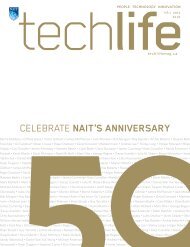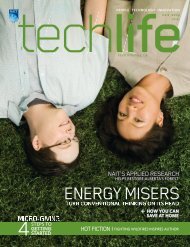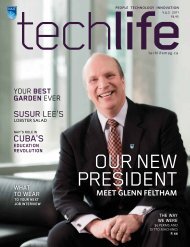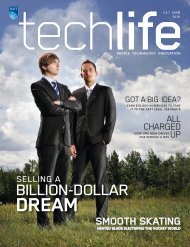SENSATIONAL
Read the full print edition - techlife magazine
Read the full print edition - techlife magazine
You also want an ePaper? Increase the reach of your titles
YUMPU automatically turns print PDFs into web optimized ePapers that Google loves.
Under the bridgeIn defence of the urban coyoteit may provide traction forvehicles during the winter, butthe salt and sand mixture used onSt. Albert bridges also gets intothe Sturgeon River, potentiallyharming the fish and invertebratesthat live there.“Additional sedimentation orsalt in aquatic ecosystems hasbeen shown to be detrimentalto aquatic life,” explains Hunt,who co-led the applied researchproject that examined the impactof road salt and sand on thewaterway.The researchers, includingsix students, collected snow andwater samples at four bridgesand at two control sites alongthe Sturgeon River. Like manynorthern cities, St. Albert uses asand and calcium chloride mixtureon roadways and bridges.With help from ALS LaboratoryGroup in Edmonton, which didsome of the analysis, as well asfunding from novaNAIT – NAIT’scentre for applied research andtechnology transfer – and theAlberta Association of Collegesand Technical Institutes, theresearchers found higherconcentrations of salt and sandin the samples taken at the fourbridges.They concluded bridge deckplowing, the spray from passingvehicles and runoff from the roadswas to blame for the problem.Leah Jackson, manager of St.Albert’s office of the environment,says similar findings have beenmade in different municipalitiesacross the country. As a result ofthe research, St. Albert will look atits snowplowing procedures to seeif anything more can be done tominimize the amount of sand andsalt getting into the river, she says.coyotes don’t appear interestedin dining on St. Albert’s dogs.The conclusion comes afterbiological sciences studentscollected and analyzed coyote scat.“We were interested in whethercoyotes were using the corridorthrough the city of St. Albert,” saysHunt. “We were also interested inwhether they were eating pets.”The research found urbangrowth isn’t stopping coyotes fromventuring into St. Albert, but thepredators generally avoid busierareas of the community, and stayaway from pets.With funding from novaNAITand guidance from University ofAlberta and Alberta governmentresearchers, three students foundevidence of coyotes along thecity’s river valley and adjacentravines, concentrated alongthe eastern and western edges,suggesting the animals areavoiding the downtown area.Hair samples from weasels,rodents, deer and even bovinewere detected in the scat, butnot from cats or dogs, indicatingcoyotes were eating a wide varietyof animals, but not pets.The coyotes use the SturgeonRiver valley corridor primarily totravel between two natural areason either side of the community,Hunt says. The study shows it’simportant to maintain naturalcorridors whenever possibleto allow for wildlife movement,she adds.photo by BLAISE VAN MALSENv5.1 2011 39










